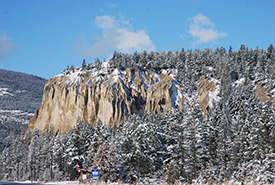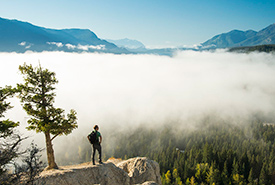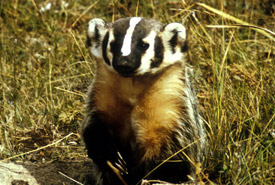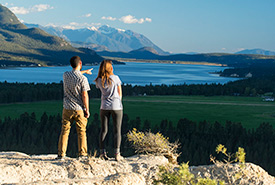Reach new heights: Take your adventure to another level by exploring the iconic hoodoos

Dutch Creek Hoodoos, BC (Photo by NCC)
Craggy spires rise up and tower over the north end of Columbia Lake. A result of thousands of years of glaciation, followed by erosion from meltwater and weather, the Dutch Creek Hoodoos are a testament to the grand geologic forces of the area.
“It’s a beautiful location, and it has amazing views of the Columbia Valley,” says Roslyn Johnson. “It’s an awesome place to go for an afternoon walk. You never know what you’re going to see.”
The former Nature Conservancy of Canada (NCC) staffer got to know this southeastern British Columbia conservation area very well when she oversaw a trail improvement project in 2017. She also assisted with the creation of an interpretive loop trail on the property.

The Dutch Creek Hoodoos Conservation Area offers amazing views of the Columbia Valley. (Photo by Steve Ogle)
“We made the walking trail more accessible and more environmentally friendly by putting in drainage and gravel so we weren’t degrading the soil,” Roslyn recalls. “We also created five interpretative panels. People can now go on a self-guided walk and learn a bit about the property, about conservation and what NCC does.”
The Dutch Creek Hoodoos Conservation Area was generously donated to NCC in 2005 by its previous owners, Jim and Gaetane Ashworth, in order to protect the ecologically and culturally important hoodoo formations.
Related blog posts
The Dutch Creek Hoodoos Conservation Area is part of a network of conservation and provincial land in the Columbia Valley. The area includes several other NCC conservation areas, such as Kootenay River Ranch, Thunder Hill Ranch, Columbia Lake – Lot 48 and Marion Creek Benchlands. Together, these areas protect vital habitat for species, including mule deer and American badger.

American badger (Photo courtesy of USFWS)
“There are so many different stories and aspects to this area that are captivating,” says Roslyn. “The geology and the wildlife. It’s all part of what makes this conservation area so interesting.”
The geologic story of the hoodoos captures the imagination of many visitors. Millions of years ago, when the Rocky Mountains were buried under a vast blanket of ice, glaciers carved jagged peaks and deep valleys. This eroded the underlying rocks into layers of gravel, sand and salt, called “glacial till.” As the glaciers began to melt 10,000 years ago, the Rocky Mountain Trench (a large valley in the northern part of the Rocky Mountains) was filled with large lakes, and glacial till collected on the lake bottoms. The Dutch Creek Hoodoos were formed out of the remnants of this glacial lake bottom.
“Standing on top of the hoodoos offers a whole other perspective,” says Roslyn. “Seeing them from the ground is cool. But standing on top and looking at the canyons, seeing the soil and how it’s all glacial lakebed material that deposited there millions of years ago — that is definitely a must-see.”

Standing on top of the hoodoos offers a whole other perspective (Photo by Steve Ogle)
The hoodoos also provide nesting and feeding habitat for a number of birds. The cliffs offer protection from the many raptors that circle the nearby fields, looking for small prey. Songbirds, such as white-throated swift and violet-green swallow, find safety for their young by building their nests on the cliff face.
“There are a number of birds that nest on the hoodoos. You can stand there and watch them flying and feeding,” says Roslyn. “Some of them are quite acrobatic. The white-throated swift is known for its rapid flight, and it certainly captures the interest of birders visiting the area.”
Before working for NCC, Roslyn had occasionally hiked at the Dutch Creek Hoodoos. Although captivated by the hoodoos, she wasn’t aware of the rich history behind the distinctive rock formations.
“I didn’t know how special this area was. I was new to the valley and knew the hoodoos were one of the classic places where visitors go,” she recalls. “Once I became involved with NCC, I learned all about the property and why it’s so important ecologically. I hope to visit this again and see my favourite flower, balsamroot, in bloom. Its large yellow flowers are absolutely gorgeous.”
The Dutch Creek Hoodoos Conservation Area is an NCC Nature Destination that you can visit year-round. For more information, click here.


